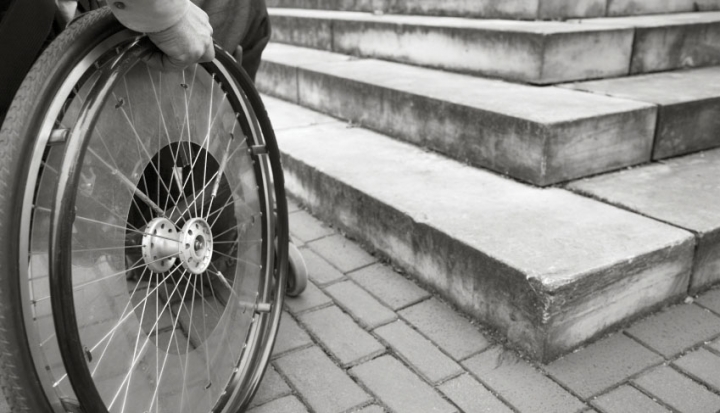Of all the body parts I didn’t expect my busted knee to affect, it was my eyes. But I’m here to tell you that the first thing that changes when you’re hobbling around is what you see. Specifically, what I see are obstacles: stairs, curbs, uneven pavement, short drops—all of which, if not negotiated properly, result in exquisite little bursts of pain.
Nowhere has this been more apparent than at church, where I have to climb three steps just to get into the building and five more to make it into the sanctuary. Heaven forbid I should be scheduled to read that Sunday (three more steps) or, worse, be a communion minister (add two more). I would never have imagined that my moderate sports-related injury would make it much harder for me to fully participate at Mass on Sunday.
Having a limp myself, I’ve also become more aware of the signals of injury in the other bodies around me. There are the obvious canes and wheelchairs, but there are also the subtle shuffles and limps of joints with arthritis, the winces when it comes time to kneel, the person whose left hand doesn’t seem to respond as well as his right.
And those don’t even touch some more “invisible” brokenness in the bodies that gather on Sunday: depression and anxiety, diabetes, multiple sclerosis, cancer, HIV, you name it. What other pain and brokenness is the body of Christ hiding?
How odd, then, that our churches so often presume that we are all “able-bodied,” all possessed not only of knees and ankles that can navigate a liturgical obstacle course but eyes that can read small print in dim light and ears that don’t ring from years of hard use as well. It’s especially odd since in the Eucharist we remember the broken, disabled body of Jesus. If anything, our gathering should be the one place in the world where broken bodies are not only on public display but are the norm rather than the “accommodated” exception—celebrated, cherished, and cared for as images of Christ.
It’s not that my parish hasn’t had conversations about making our church building more “accessible”—which means we are looking for a place to install an elevator for people who have a hard time negotiating stairs. That’s fine, as far as it goes, but it’s a far cry from really honoring the members of Christ’s body who don’t meet the customary standards of mobility. An elevator may help a sister in Christ who travels with a wheelchair to get into church and settle in a “designated parking place,” but it won’t make it possible for her to be a lector if she’s so inclined and gifted. Her full, conscious, and active participation will still be impaired.
It would be easy to dismiss such concerns as an overabundance of political correctness or merely a question of architecture. But if we take the incarnation seriously—a God who has a human body—then something more is required.
That’s not to say we shouldn’t be talking about accessibility and building improvements, but the goal isn’t so much meeting the standards of the Americans With Disabilities Act—which, incidentally, religious groups lobbied to be exempted from—as it is the acknowledgment that the glory of God is the broken body of Christ, the mystery we celebrate in every Eucharist and receive in every communion. When we gather, that brokenness made present in us deserves all the honor and care we can muster, even if it requires a wrecking ball on our “beautiful” old church.
In my former parish there was a family with a son who had cerebral palsy and traveled in an enormous motorized chair—actually more like a stretcher. When the parish renovated its century-old building, its members chose to place moveable seats up front so there was always room for him not only to “sit” for liturgy but to drive his chair forward to receive communion. He got in line with the rest of us “able” folks—that is, those of us able to hide our pain—and led us to the table. Communion has never been quite the same.
This article appeared in the February 2013 issue of U.S. Catholic (Vol. 78, No. 2, page 8).
Image: iStock/RelaxFoto.de














Add comment